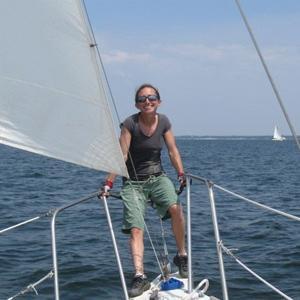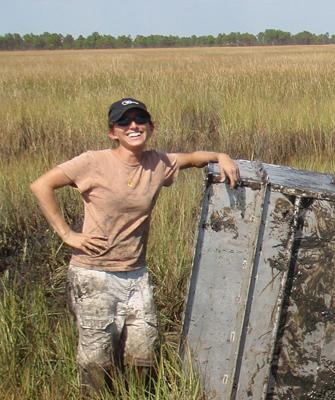Meet EPA Scientist Sandy Raimondo, Ph.D.
Modeling for a Healthier Environment
Sandy Raimondo, Ph. D., is a research ecologist  Off duty, enjoying the adrenalin of a sailboat race in Pensacola Bay. at EPA’s Gulf Ecology Division in Gulf Breeze, Florida. She is currently working on the development and application of models that predict ecological effects of chemical contaminants, with special focus on endangered species. When not working, Sandy spends her free time racing sailboats, surfing (or waiting for surf), and endlessly remodeling her home.
Off duty, enjoying the adrenalin of a sailboat race in Pensacola Bay. at EPA’s Gulf Ecology Division in Gulf Breeze, Florida. She is currently working on the development and application of models that predict ecological effects of chemical contaminants, with special focus on endangered species. When not working, Sandy spends her free time racing sailboats, surfing (or waiting for surf), and endlessly remodeling her home.
What research are you doing at EPA?
The main thing that I hope to accomplish with my research here at EPA is to help improve how EPA decision makers and risk assessors evaluate chemical impacts on the environment. There’s a lot of uncertainty in the way a chemical is evaluated and its impact on animals. For example, there may be very little information out there on a chemical’s potency, toxicity, or what types of effects it’s going to have on an organism. We have to figure out what those impacts could be based on very little information. To accomplish this, my colleagues and I create ecological models to assess the impact of chemicals on various organisms in the environment.
Typically, in our ecological models we use information from studies on a surrogate species. In other words, you’re looking at how to protect all of these different species in an ecosystem based on what we know that’s been measured on one or two species. We need to take the information that we have of the chemical impacts on these surrogate test species and try to understand how that may or may not be representative of all the other types of species that are out there.
What is the importance of ecological modeling?
Ecosystems are some of the most complex things that we can try to wrap our brains around. An organism’s body is contained within itself, and we can dissect it and pull it apart to see how it works. But, when you go outside of the organism and you look at things in an ecological context, you’re dealing with many interactions; interactions with the physical environment, with other organisms, with plants and animals, and with unpredictable events. In a way, it’s just a complex puzzle. There’s no way that we could dissect the ecosystem and really see what’s communicating with what at any given point in time. So, we have to rely on models to fill in those holes. Then we can try to build the puzzle with those modeled pieces.
Can you tell us about your background?
I have always been a biology nerd. When I was in high school, it was always my favorite subject, so I knew that was the direction I was going in. When I was an undergrad at Penn State, I got involved in an entomology lab studying insects and absolutely loved it. I diverged from that when I got my master’s in herpetology, which is the study of amphibians and reptiles. I did that for 3 or 4 years and had a blast working in different parts of the country and working with different types of amphibians. However, when I decided to go back for my Ph.D., I wanted to return to entomology.
I did my Ph.D. dissertation on the impacts of gypsy moth management practices on non-target moth species. It looked at different types of pest management options and how they affected native species. So, that got me interested in pesticides and different types of alternate management practices. That kept me busy up until about 11 years ago when I graduated with my Ph.D. and got hired at the Gulf Ecology Division studying pesticide impacts on estuarine crustaceans and fish.
 A good day in the life of a field biologist in an estuarine marsh along the Gulf coast.
A good day in the life of a field biologist in an estuarine marsh along the Gulf coast.- insects throughout the Northeast;
- salamanders in the Central Appalachians;
- frogs in the Carolina Bays of South Carolina;
- amphibians in the deserts of Texas; and,
- now, I’m here on the Gulf Coast working with fish and crustaceans in estuarine ecosystems.
What do you like most about your research?
I love population ecology, and I love working with any animal species. I could do population ecology anywhere, but what I love most about my research at EPA is being right on the doorstep, if not through the door, of the science that helps make a difference for our environment. Being able to do something that’s able to inform policy and help set regulations is a really big motivator and driver for the work that I am doing here.
If you weren’t a scientist, what would you be doing?
If I weren’t a scientist, I would probably be an organic farmer. That goes back to my Ph.D. advisor, who was also a leader of the West Virginia University organic farm where she was directing entomology work. On an organic farm, you have to figure out how to keep your tomatoes growing without using pesticides, and that can be a huge challenge. That answer may be cheating because it is science, and it is research, but you may not be able to get me away from that!
Do you have any advice for students considering a career in science?
I tell a lot of students who ask me for advice on graduate school to be completely certain that it’s what they want to do. Make sure that you know when you make that decision because it’s not a walk in the park, it’s a commitment. There are a lot of students that have just finished their undergraduate degree and want to go straight into a Ph.D. program, and that may be the right thing for some people who know what they want to do, but, for people who are uncertain, I recommend a masters.
